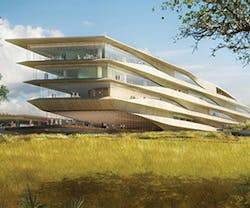Global Report: Three Forward-Thinking Projects
Botswana Innovation Hub, SHoP Architects
Gaborone, Botswana
The Botswana Innovation Hub will be the country’s first science and technology park. It is part of the country’s long-term strategy to move towards a technology-driven and knowledge-based economy.
Developers hope the park will attract companies, universities, and research and advanced training institutes that will promote a culture of competitive innovation. They tapped SHoP architects to create “an iconic yet timeless building which employed the most advanced green technology available.”
To that end, SHoP created an “Energy Blanket” roofscape concept, combining passive and active sustainable energy techniques, including large shade overhangs, water collection and re-use mechanisms, and photovoltaic systems.
The 310,000-square-foot facility has already attracted an HIV Research Lab run by the Ministry of Health in partnership with Baylor University, Harvard University, and the University of Pennsylvania.
Masdar City, Foster + Partners
Abu Dhabi, UAE
In 2006, Masdar-Abu Dhabi Future Energy Company set out to develop Masdar City as the world’s first zero carbon, car-free city and a new hub for clean tech in the Middle East. They have faced road bumps along the way (like the 2008 economic downturn), but now the project is just one year away from Phase I completion, and the population is expected to grow from 1,000 to 4,000 by the end of 2014.
While the city does technically have cars (fleets of driverless electric ones, along with some clean-energy mass transit vehicles), it does not have light switches or water taps. Replacing them with movement sensors has cut both water and electricity consumption by more than 50 percent. Whatever electricity is used comes from 87,000 solar panels located just outside the city, and 80 percent of used water is recycled for things like crop irrigation.
Perhaps most surprisingly, the streets of Masdar are generally 25 degrees cooler than the surrounding dessert, thanks to a breezy, shady system of design elements Foster + Partners developed by studying the techniques used in ancient cities throughout the region.
Khed Special Economic Zone, HOK
Pune, India
The U.S. National Intelligence Council’s 2013 “Alternative Worlds” report forecasts that by 2030 our system of global governance may be marked by networks of public-private partnerships, in which governments subcontract responsibilities to third parties in exchange for limited autonomy.
But why wait? We have seen the proliferation of Special Economic Zones (SEZs)—essentially industrial para-states—for decades. In India, annual SEZ exports have jumped from $2.5 billion to $65 billion in just 10 years as third-party subcontractors like Bharat Forge, Ltd—the country’s largest manufacturer and exporter of automotive components, and developer of the Khed SEZ in Pune—operate on the outskirts of regulation.
The Fully Integrated Thinking (FIT™) framework, developed by HOK and Biomimicry 3.8, served as the backbone of the entire project, led by HOK Directors of Planning Jeff Davis and Chris Fannin. By the end of Phase II, the industrial city will house 2 million people in “an urban context” roughly the size of Manhattan “that systematizes human need, environmental stewardship, and economic viability, creating a global model of urbanism where residents will live in harmony with nature.”
